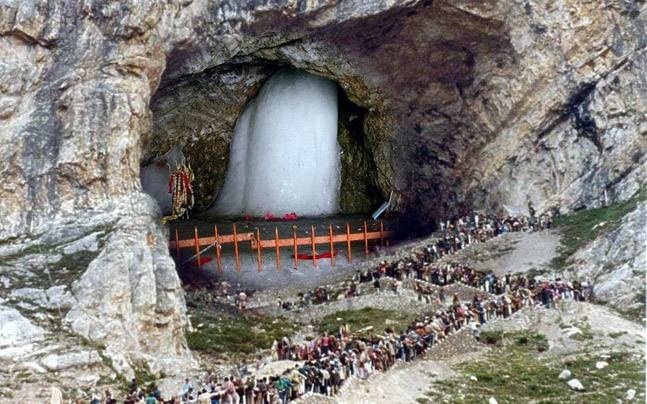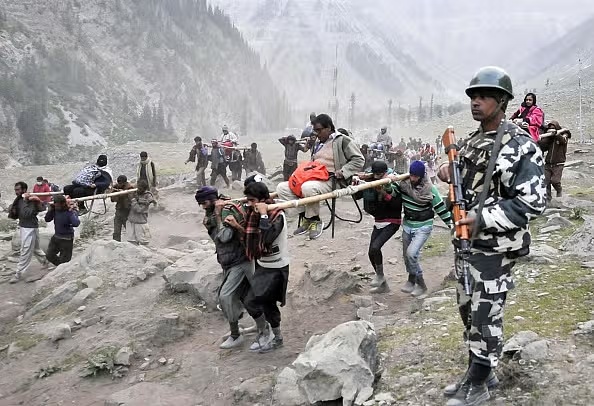KEY POINTS
- 7 Amarnath pilgrims killed in a terror attack on July 10, 2017.
- Bus violated safety rules, travelled after dark without escort.
- Attack led to stricter security and yatra travel reforms.
The annual Amarnath Yatra, considered one of the most sacred pilgrimages for Hindus, has long symbolized religious devotion, endurance, and national unity. However, on the night of July 10, 2017, this spiritual journey turned into a nightmare when terrorists ambushed a bus carrying Amarnath pilgrims, killing seven and injuring twelve others. The incident occurred in Anantnag’s Batengo area on the Srinagar-Jammu National Highway, sending shockwaves across the country and igniting a national conversation on pilgrimage security in terror-affected zones.
What Happened That Night?
The pilgrims were travelling in a private mini-bus operated by Om Travels, which was returning from the Amarnath shrine to Jammu. The bus was not registered with the official Shri Amarnath Shrine Board (SASB) and had violated security protocols by traveling after sunset, when official convoy protection had ceased.
At around 8:30 PM, terrorists attacked a patrol vehicle in the Batengo area, which lies in the Khanabal sector of the Anantnag district. During this ambush, the unescorted pilgrims’ bus got caught in the gunfire. Bullets pierced through the sides of the vehicle, resulting in multiple fatalities and injuries.

Casualties and Victims
The attack claimed the lives of seven innocent devotees, six of whom hailed from Valsad district in Gujarat, and one from Daman. The bus had about 60 passengers, mostly from Surat, Valsad, and Daman. Many of the injured were rushed to nearby hospitals in critical condition.
Gujarat Chief Minister Vijay Rupani announced that the bodies and the injured would be flown back to Gujarat via a special Indian Air Force aircraft. This rapid response reflected the gravity of the attack and the coordination between state and central agencies.
Security Lapses and Protocol Violations
The attack exposed glaring lapses in security. As per official protocol, all vehicles carrying Amarnath pilgrims are required to travel during daylight hours, with Army and CRPF Quick Response Teams (QRTs) deployed along the route.
However, this particular bus:
- Did not register with the Shri Amarnath Shrine Board.
- Travelled after dark, violating a key advisory.
- Was not accompanied by a security convoy, making it an easy target.
Furthermore, it was revealed that QRTs had withdrawn after sunset, making the highway segment more vulnerable to militant activity. This withdrawal coincided fatally with the time the bus reached the attack zone.
ALSO REA: “This Day in The History | The Amarnath Pilgrimage Attack: A Tragic Event”
Who Carried Out the Attack?
Though no group officially claimed responsibility, security agencies attributed the attack to Pakistan-backed terror outfits operating in South Kashmir, particularly in Anantnag and Pulwama districts, which were known hubs for Lashkar-e-Taiba (LeT) and Hizbul Mujahideen at the time.
Initial investigations pointed towards Abu Ismail, a top LeT commander, as the mastermind. He was later neutralized by security forces in September 2017 in Srinagar.
A History of Violence Against the Yatra
Despite being one of the most sensitive religious pilgrimages, the Amarnath Yatra has rarely been directly targeted by terrorists. The 2017 attack was only the second major terror assault on the pilgrimage in over three decades of insurgency in Kashmir.
In August 2000, militants killed 21 pilgrims and security personnel in Pahalgam, making it the deadliest attack on the yatra to date.
Since then, heightened security arrangements had kept the yatra largely safe until 2017 shattered that streak.
The Route of the Yatra: A Difficult Pilgrimage
The Amarnath Cave Shrine, dedicated to Lord Shiva, is located at an altitude of 3,888 meters in Jammu & Kashmir’s Lidder Valley, surrounded by glaciers like Kolahai and Nehnar.
Two main routes lead to the cave:
- Pahalgam Route (46 km) – Takes 2–3 days.
- Baltal Route (14 km) – Covered in 5–6 hours.
The terrain is treacherous, with narrow paths, steep cliffs, oxygen deficiency, and unpredictable weather. In 1996, over 250 people died due to a snowstorm and blizzard. In 2015, a cloudburst near Baltal killed 3 and injured 11.
Despite these risks, lakhs of pilgrims undertake the yatra each year, driven by faith and devotion.
Impact on Pilgrimage Security and Policy Changes
Post-attack, several changes were made to Amarnath Yatra protocols:
- Mandatory registration with the Shrine Board.
- Strict night travel restrictions.
- Use of RFID tracking, CCTV surveillance, and drones for monitoring.
- Enhanced mobile coverage and medical preparedness along the route.
- All yatri vehicles now move in escorted convoys with scheduled timings.
2019 and the Shadow of Threat
In 2019, the government abruptly called off the yatra on August 2, just days before revoking Article 370, citing new intelligence inputs of possible terror attacks.
Though no such attack occurred, the move reflected increased caution in light of the 2017 incident. The government also launched a communications and security lockdown across the Valley, which has since only partially eased.
The 2017 Amarnath Yatra attack was not just an act of terrorism; it was a strike against India’s spirit of pluralism and the unwavering faith of pilgrims who brave danger to visit the sacred cave.

















Comments